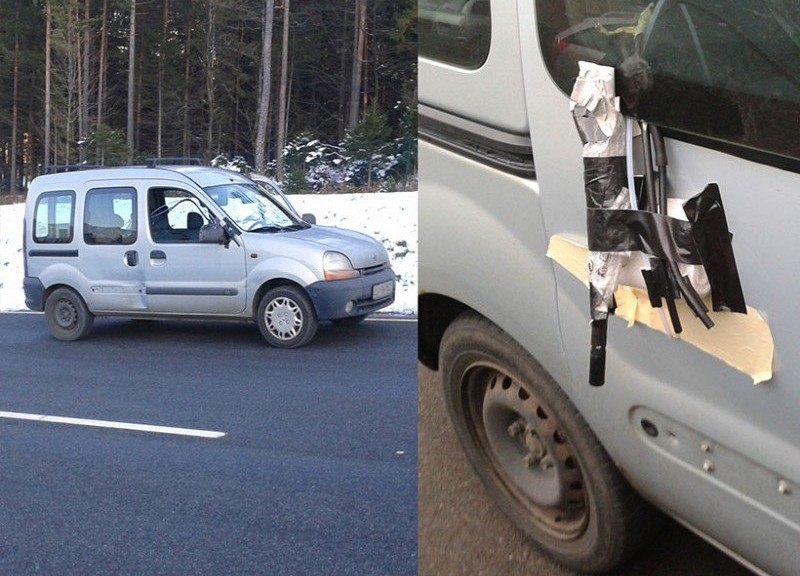A new pollution study in Europe using a van to chase other vehicles and measure their tailpipe emissions finds that newer, diesel-fueled, heavy trucks and buses emit, on average, 34% more of the health and climate hazard known as black carbon than older vehicles of the same types.
The unexpectedly dirty exhaust from heavy vehicles newer than 5 years old, compared with that from 5- to 10-year-old vehicles, may indicate that modifications by vehicle manufacturers to lessen other pollutants have had the undesirable side effect of boosting engines’ black carbon output, the researchers suggest.
The new findings raise questions about truck and bus emissions just as the Obama administration proposed on Friday stricter U.S. truck standards that would improve the fuel efficiency of an array of medium- and heavy-duty vehicles and cut their carbon dioxide emissions by an estimated 16%. The new rules do not explicitly address black carbon.
Commonly known as soot, the combustion by-product black carbon is the second most important contributor to global warming. It has also been implicated in long-term human pulmonary and cardiovascular problems. Black carbon comes from many sources, but the Diesel Technology Forum, an industry group in Washington, D. C., estimates that diesel accounts for a quarter of worldwide black carbon emissions.
It has not been easy to link some pollutants from vehicles, such as black carbon, to emissions sources. Governments seeking to regulate vehicle exhaust often depend on laboratory testing of preproduction models of new vehicles and computer simulations for assessing compliance to emissions standards. Once the preproduction models achieve certification, manufacturers are allowed to sell the production models to the public. Yet a growing number of studies are showing that such tests used to certify vehicles do not match real-world vehicle performance.
Seeking on-the-road data for black carbon and several other pollutants, a team led by atmospheric chemist Griša Močnik of Aerosol, a company in Ljubljana, Slovenia, took to local highways with its instruments and recorded the first measurements of black carbon from a selection of cars, trucks, and buses representative of Europe’s vehicle fleet.
The researchers installed several instruments in a passenger minivan: one device measured black carbon while others gauged nitrogen oxide and carbon dioxide. Another instrument captured tiny particles. The team taped air intake tubes to the outside of the van and drove Slovenian roads for a week.
In all, the scientists measured emissions from 139 diesel- or gasoline-fueled cars and diesel-fueled heavy vehicles (trucks and buses weightier than 1305 kilograms), allowing the researchers to analyze how emissions vary with vehicle type, age, and power-to-weight ratio.
Why black carbon from such vehicles may be on the rise in the face of tightening controls to cut back on pollution emissions remains a matter of speculation, Močnik said. But technological efforts to limit nitrogen oxide emissions might be a factor, he suggested.
Some manufacturers use selective catalytic reduction, a kind of chemical scrub, in heavy vehicles and diesel particulate filters—a mechanical system—in lighter ones, Močnik noted. The chemical scrub might be plucking out nitrogen oxide and letting through black carbon, he suggested. Engine operating temperatures also influence how much of each pollutant an engine produces.
Although the proposed new U.S. truck standards do not address black carbon emissions, they do include revised emissions certification methods to better reflect real-world vehicle performance.
Except for the black carbon rise in newer heavy vehicles, the measurements reported by Močnik and his colleagues in a study published 8 June in Atmospheric Chemistry and Physics Discussions confirm that nitrogen oxide and particulate emissions are dropping in most types of vehicles. This broad emissions decline jives with similar reductions found by many different research teams and is a trend that the U.S. Environmental Protection Agency attributes to increasingly stringent regulation.
Still, another surprise that the on-road data revealed was a relatively high rate of emissions from diesel passenger cars versus heavy vehicles, Močnik said. Overall, diesel passenger cars produced more pollution per liter of fuel burned than heavy diesel vehicles such as buses and trucks. The discrepancy may stem from a greater demand in the commercial vehicle market for more fuel-efficient, and therefore cleaner, vehicles because fuel consumption inflates fleet expenses and eats into profits, Močnik speculates.
Black carbon is not a common target of vehicle pollution studies, said emissions researcher Vicente Franco of the International Council on Clean Transportation (ICCT), a mostly foundation-supported transport regulation think tank in Brussels, Belgium. Instead, researchers and regulators tend to focus on carbon dioxide, particulate matter, and nitrogen oxide.
Franco, for example, showed last year in a metastudy that the 15 new diesel cars he used as a sample emitted around 7 times the legal limit of nitrogen oxide. That study did not cover black carbon.
Franco added that the ICCT is concerned that manufacturers may be designing engines that cut emissions only during certification tests and emit more the rest of the time—a practice called “cycle beating.” Measurements like those by Močnik’s team, checking multiple types of vehicle fleet emissions throughout the entire driving cycle, could potentially shed light on whether such suspicions are warranted.
